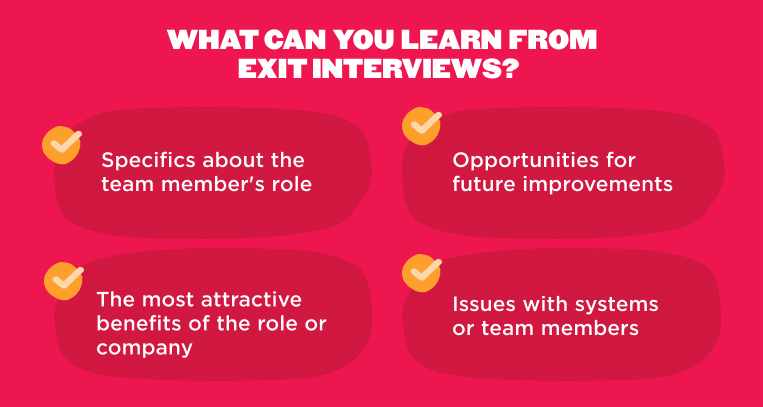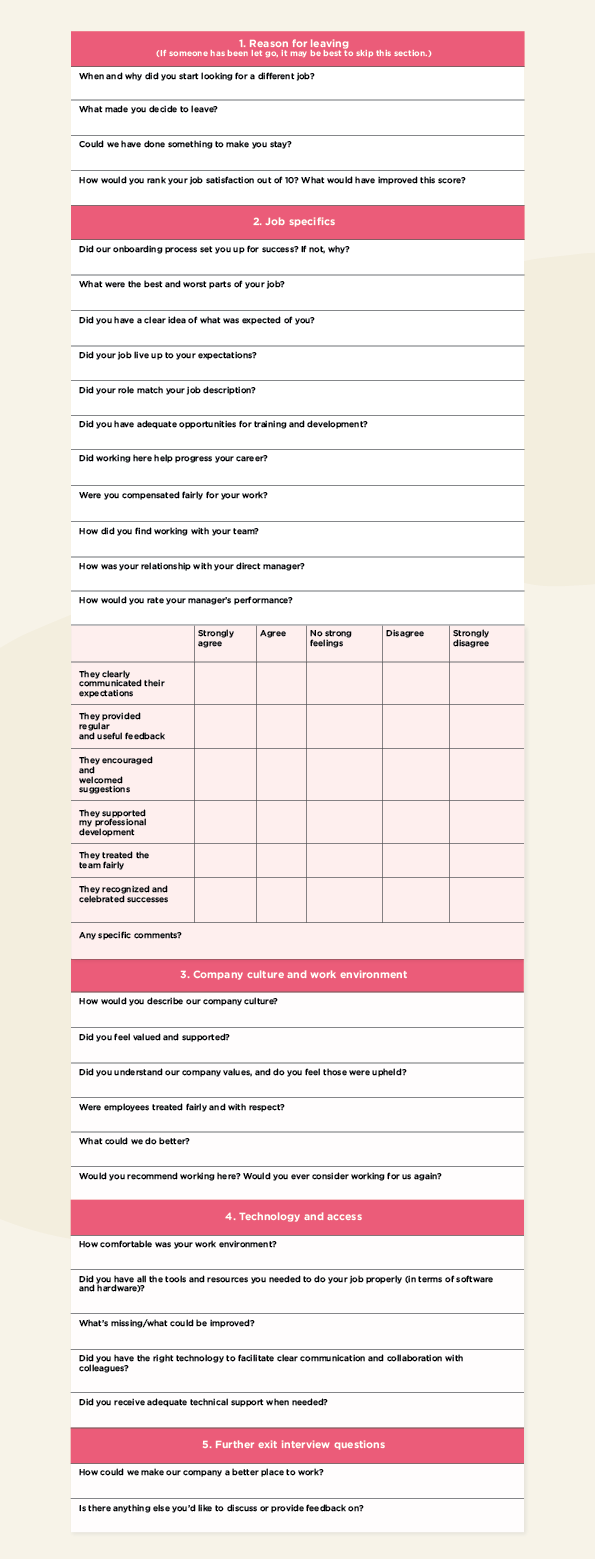How do you say goodbye?
Parting ways with team members can be a tricky, even emotional affair. Depending on the context, it can feel like the best thing to do is limit communication and move forward with a replacement hire.
But, a team member’s exit interview presents a golden opportunity to learn about your company and how to improve retention rates and the employee experience your organization provides for the long term.
How you say farewell says a lot about your company culture and the effort you make to create a happy and healthy environment for everyone.
These days, people leave companies for all sorts of reasons, and it’s possible to give your people a positive leaving experience. This is why, as an HR leader, it’s important to carefully consider your offboarding process and include an exit interview for everyone.
Getting it right will give you specific insights into why people leave your company. This critical data will allow you to reinforce the holistic approach you take to individual satisfaction and help maintain a happy relationship with people who may return someday.
This exit interview guide will highlight the benefits of conducting exit interviews, what to watch out for, and the questions to consider to keep things on the right track.
Want to skip right to the interview questions? Download our free employee interview template:
What is an exit interview?
An exit interview is a conversation you may want to have with a team member when they’re leaving your organization. This conversation can help you gain insights into the team member’s experience working with your company and better understand why they’re resigning.
Exit interviews are also unique opportunities to collect candid feedback. It’s best to approach them as significant learning opportunities, rather than just more elements to mark as complete on the checklist. In all likelihood, you’ll uncover issues to improve that might otherwise have gone unnoticed.
It’s well worth preparing questions in advance and creating a structure for the conversation to ensure the most productive and valuable exit interviews.
Why do exit interviews matter?
Regardless of the reason behind a team member’s departure—and whether they resigned or were let go—exit interviews are an important part of a truly effective HR process. They can reveal areas for improvement and play a significant role in creating a happy and healthy working environment for all of your people.
Exit interviews are a key step in offboarding and help give people a positive experience with your company. They provide a unique setting in which people are more likely to feel comfortable sharing their true thoughts and feelings. Exit interviews also help show people that the company genuinely cares about their opinions, suggestions, and insights.
Ultimately, they’re part of creating a company culture that supports a positive employee experience and an open feedback culture. HR leaders can reduce turnover by collecting and implementing exit interview feedback by making changes to company policies and employee benefits packages to increase employee satisfaction and happiness.
A positive employee experience also has a strategic impact on your business. For example, with the prevalence of boomerang employees, parting ways with people on positive terms can have a significant impact on the likelihood of team members returning.
Who conducts exit interviews?
People may feel more comfortable giving feedback to someone who isn’t their direct manager. Because exit interviews entail asking departing team members strategic (and sometimes, sensitive) questions, a neutral third party, like an HR representative, typically conducts them. However, managers and HR personnel may conduct the interview together depending on the company and the circumstances behind a team member’s departure.
You can conduct exit interviews in person or online and they typically take about 30 minutes to an hour.
What kind of things can you learn from an exit interview?
- Specifics about the team member’s role. This is especially useful if you discover that it differs from how it is currently defined. It will help you create a more accurate and specific job description when recruiting a replacement.
- Opportunities for future improvements. A leaver’s candid suggestions and criticisms are a great source of information to help you identify areas of friction you can address to increase workplace happiness and improve retention in the future.
- Issues with systems or other team members. In pursuit of making your operations as efficient as possible, exit interviews can help uncover bottlenecks or issues deep within your organization.
- The most attractive benefits of the role or company. Take the positive selling points you discover and feed them into future recruitment drives to help attract and retain top talent.

What should the ideal exit interview cover?
Here are some of the main areas to consider when planning your exit interview:
Cover the basics
From time to time, people might come to exit interviews with a clear issue they’d like to discuss with you. While that’s helpful to hear about, it can quickly railroad your planned conversation and take time away from other issues.
Keeping a checklist of the basic topics—and areas of conversation—is a great way of making sure you cover all the bases.
Discuss key relationships
Departing team members have first-hand experience working alongside colleagues and with direct managers. An exit interview is one of the only times they’ll feel comfortable giving honest feedback on their strengths and weaknesses and the specific dynamics of the team.
Reasons for leaving
Think about long-term, structural issues such as career progression, a change of environment and pay structure, as well as short-term triggers, such as specific projects, a change in team make-up, and any specific issues that might have occurred.
Any perks, benefits, and opportunities they feel are missing
In a competitive hiring environment, keeping track of the specific benefits others may be offering is key to staying in the race. Modern professionals value perks like:
- Regular learning and development opportunities
- Performance bonuses
- Comprehensive healthcare coverage
- Insurance plans
- Wellness programs
- Childcare support
- Flexible work arrangements
- Retirement plans
These are key considerations your competitors might use to attract the best talent. Make sure to ask resigning people about how satisfactory the organization’s employee benefits are and if there’s something more they would have liked.
Further actions
Finally, if more serious information comes to light during the exit interview that warrants immediate further action, be sure to establish whether or not you can follow up with the ex-team member. This will demonstrate your willingness to address an issue and your determination to resolve it.
Pro tip: To gather the most useful data, stick to a consistent format across all of your exit interviews. This protects anonymity, keeps things fair, and helps you identify patterns.
What is an exit interview template?
An exit interview template is a helpful guide for HR leaders who want to ask open-ended questions to team members leaving the company. The questions in the template typically prompt lengthy discussions with the team members. The template can also help HR managers stay focused when conducting interviews so they can collect valuable feedback.
The best templates include general questions about why the person is leaving, job circumstances, company culture, and work environment—information that helps you create a structure to manage your workforce effectively. It can also include questions about specific areas within the organization.
For example, if the company uses a learning management system (LMS), the interviewer might ask questions about whether the individual found the tool useful and if it contributed to their career growth.
Exit interview questions to ask departing team members
This exit interview structure is intended to help you keep the conversation focused and productive while creating a positive employee experience. It’s broken up into five sections. Feel free to use it as a baseline for creating your own exit interview questionnaire:
Download your employee exit interview template
Here’s your printable exit interview template. Feel free to use it as a baseline for creating your own exit interview strategy.
<<Download, print, and use this exit interview template for a proper farewell.>>
How to conduct a successful exit interview
Try some of these helpful tips the next time you conduct an exit interview.
1. Clearly communicate the purpose of the interview
Start by clearly communicating the purpose of the exit interview to the individual. Inform the individual that you’d appreciate honest feedback about their experience in the company.
2. Offer different exit interview formats
Productive exit interviews aren’t only about the questions you ask and the way in which you steer the conversation. The format and setup of the offboarding process can also heavily influence how much the person you’re interviewing is willing to share.
People have different comfort levels when it comes to face-to-face HR meetings, so it’s worth considering offering a range of interview formats people can choose from. For instance, you might offer a written form as an alternative, or a video or phone interview in lieu of an in-person meeting.
Some team members may also feel more comfortable sharing their thoughts once their term of employment has expired since this can lift their confidence in the anonymity of the process.
3. Send exit interview questions in advance
Sending over the questions in advance can give people a chance to prepare and understand which areas you’d like to cover. That way, you’re likely to get deeper insights rather than off-the-cuff answers. However, another approach is to only provide general information about the interview questions so you can capture honest, candid feedback.
Creating a comfortable environment will help individuals tell you what they really think—and give you the most useful information possible.
4. Choose the right date, time, and interviewer
Make it easy for the individual to take part in the interview by scheduling the exit interview as close as possible to the end of their notice period and during their workday. Choose a date and time that fits into their offboarding schedule.
It’s also important to choose the right interviewer. Whoever you choose must be neutral and someone the person is comfortable with. For example, a leaving team member may not be comfortable giving negative feedback to their direct manager.
5. Encourage transparency and listen carefully
Make it clear that all feedback will be confidential and used to improve organizational processes. This helps create a non-judgmental environment where people can feel comfortable expressing their opinions.
During the interview, listen carefully to what the person has to say. Keep in mind that an exit interview is not for you to address concerns or counter team members’ opinions. It’s important to avoid being defensive. This shows you value their feedback.
Pay attention to nonverbal feedback (tone, body language, emotions). For example, the person says they were valued and supported—but their voice lacks enthusiasm and they avoid eye contact. This indicates there’s an issue they don’t want to address. In situations like this, you can encourage people to speak up by asking open-ended questions like, “Is there anything specific that could have been better during your time here?”
When you demonstrate genuine interest and concern, you’ll get in-depth reviews that can help improve company culture, support your current team member’s experience, and reduce attrition risk.
6. End the interview positively
Once you’ve concluded the interview, thank the person for their time and feedback and review everything they said. You can also allow them to review their feedback before you record it in their personal file.
Ending the interview positively reflects on the organization’s culture and reputation. It fosters goodwill even after people leave and leaves room for collaboration in the future.
Pro tip: Offer any additional support and assistance that the company can provide during their offboarding, such as providing references.
7. Document and analyze the feedback
Document and organize the individuals’ feedback into categories such as what they liked about the organization, what they disliked, and their suggestions for growth. Analyze the feedback to find trends and patterns and make strategic improvements in company culture, internal processes, employee engagement, training and development programs, and overall job satisfaction.
This practice not only benefits current staff but can also attract future talent.
8. Keep everything confidential
Maintaining confidentiality throughout the process ensures the individual’s privacy. It’s also good practice to keep everything confidential, even after they leave. This involves storing all surveys and written and audio feedback in a secure location accessible only by authorized personnel.
Avoid sharing specific details of the exit interview with the individual’s direct manager unless necessary.
<<Download, print, and use these exit interview templates for a proper farewell.>>
Learn more about exit interviews
Here’s additional information to help you with conducting an exit interview:
What should you not say in an exit interview?
Treat departing team members with respect and professionalism, regardless of why they’re leaving. During the interview, try to avoid:
- Gossip or hearsay about the individual
- Criticisms about their performance
- Issues that have already been addressed in the past
- Words that make the person feel guilty about resigning
- Asking the individual to reconsider
Should you use the same exit interview questions each time?
Using the same exit interview questions for each departing team member can provide consistency, which allows for better comparison and analysis of data over time. It also ensures that everyone is given an equal opportunity to provide feedback on similar aspects of their experience.
However, it’s important to recognize that not all roles, relationships, or experiences within a company are the same. You can add customized questions relevant to specific departments, levels of seniority, or the circumstances surrounding the person’s departure. Include some open-ended questions to provide people with an opportunity to share their unique insights.
<<Access all the right questions with this free exit interview template.>>
Can a departing employee decline an exit interview?
Yes, it’s okay for people to decline their exit interview. Participation in exit interviews is typically voluntary and leavers aren’t obligated to take part if they’re uncomfortable with the process.
Is an exit interview good or bad?
An exit interview gives businesses the opportunity to collect honest feedback from departing team members. Exit interviews provide teams and businesses with a richer understanding of which internal processes (i.e., training, promotions, communication) are effective and which policies they may need to scrap or update to retain and attract new quality talent.
For individual contributors, a constructive exit interview provides the opportunity to leave the company with a clean slate. People can provide feedback about their work experiences, voice concerns, and suggest improvements.
Does your company need to host exit interviews?
Exit interviews aren’t required, but they’re a great way to gain insights into people’s satisfaction with your organization.
Recommended For Further Reading
Where should an exit interview occur?
Host exit interviews in a private area where the interviewer and departing team member feel comfortable. You can hold the meeting remotely or in person.
Exit interviews and your future success
At the end of the day, an exit interview is likely to be the last direct experience a person has with your company. So getting it right and making sure they feel heard and respected goes a long way towards leaving them with a positive overall impression.
Adapting our exit interview questions template and preparing in advance can help you conduct productive meetings that contribute to a positive and amicable parting. You’ll reap the rewards of highly valuable feedback on what it’s like to work for your company, and your ex-team members will take away a positive final experience that they can share in conversations with friends, relatives, and future colleagues alike.
When deeply rooted in your company culture, a productive exit interview might even turn out not to be an ending after all, but merely the start of a new relationship that culminates in a valued professional’s eventual return.

